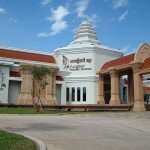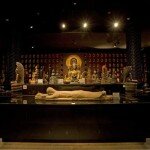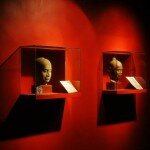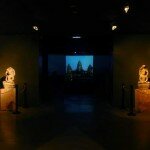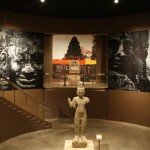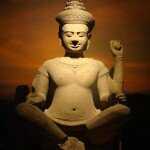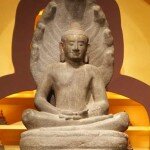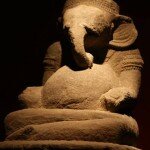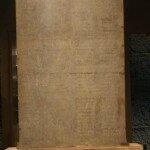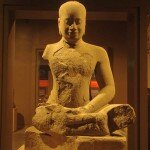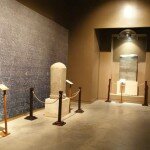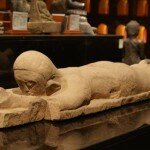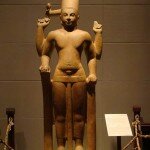 A friend of ours, Leigh Leibel, recently visited Siem Reap. She was lauding the Angkor National Museum so much, we persuaded her to write this article. I hope you enjoy it and we hope that we can persuade Leigh to write more for us in the future. Thanks Leigh.
A friend of ours, Leigh Leibel, recently visited Siem Reap. She was lauding the Angkor National Museum so much, we persuaded her to write this article. I hope you enjoy it and we hope that we can persuade Leigh to write more for us in the future. Thanks Leigh.
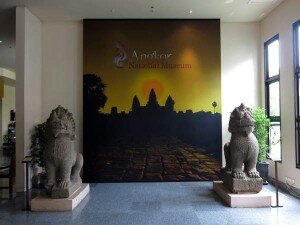 “My tuk-tuk was zipping along the road to Angkor Wat when I noticed a sprawling white building off to the left – a curiously gaudy complex with pink walls and enormous burnt orange tiles; its roof punctuated with sun-bleached stupas that were oddly reminiscent of the Angkor temples I was on the way to visit.
“My tuk-tuk was zipping along the road to Angkor Wat when I noticed a sprawling white building off to the left – a curiously gaudy complex with pink walls and enormous burnt orange tiles; its roof punctuated with sun-bleached stupas that were oddly reminiscent of the Angkor temples I was on the way to visit.
I leaned in toward my driver. “What IS that building, Mr. Suthy?”
“Oh“ – he said. “That’s the Angkor National Museum. It’s air-conditioned. Want to stop and cool off?”
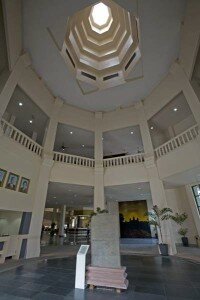 And so, embarrassingly, that was how I stumbled upon the five year old Angkor National Museum – a world-class cultural learning institute “hidden” in plain sight.
And so, embarrassingly, that was how I stumbled upon the five year old Angkor National Museum – a world-class cultural learning institute “hidden” in plain sight.
Unbelievably, I spent four mesmerizing hours wandering its halls, the audio tour and numerous documentary films guiding me on a fascinating journey through the historical, cultural, artistic and religious life of the mighty Khmer empire. For anyone who wants to learn more about the early history of Cambodia before heading off to visit her magnificent temples, this is your Nirvana.
Upon entering ANM, visitors are welcomed by a lovely interior space, modern and multi-storied – with eight exhibition galleries grouped thematically around an atrium with reflecting pool and skylight. On the second floor, huge statues – plundered and recovered from the temples – line the corridors and introduce several of the gallery spaces.
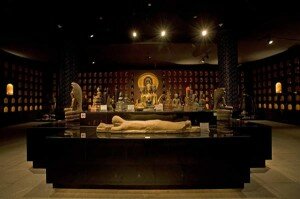 The collection itself is made up of more than one thousand artifacts transferred from the Angkor Conservation Site and the National Museum in Phnom Penh. Each of the eight galleries is beautifully presented and wonderfully informative; certainly, there is something here for everyone. From the pre-Angkor period (1s – 8th century) to the Golden Age of the Khmer Empire (9th to mid-14th century) – and beyond … there is much to explore:
The collection itself is made up of more than one thousand artifacts transferred from the Angkor Conservation Site and the National Museum in Phnom Penh. Each of the eight galleries is beautifully presented and wonderfully informative; certainly, there is something here for everyone. From the pre-Angkor period (1s – 8th century) to the Golden Age of the Khmer Empire (9th to mid-14th century) – and beyond … there is much to explore:
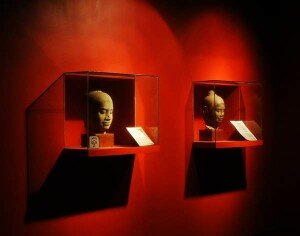 The ancient trade routes and wars that ravaged these tranquil lands; the myths and folk tales that influenced Angkorian sculpture and architecture; the confluence of Brahmanism (Hindu), Animism and Buddhism and its manifestation at Angkor; the lives, wives and politics of the 4 god-kings who built the great Angkor civilization.
The ancient trade routes and wars that ravaged these tranquil lands; the myths and folk tales that influenced Angkorian sculpture and architecture; the confluence of Brahmanism (Hindu), Animism and Buddhism and its manifestation at Angkor; the lives, wives and politics of the 4 god-kings who built the great Angkor civilization.
Whew!
For those short on time, one of the more popular attractions for both children and adults is a time-lapse video of the equinox sunrise over Angkor Wat – along with a tabletop replica of the Temple that offers perspective around its conception and engineering. See Gallery D – Angkor Wat: Heaven on Earth.
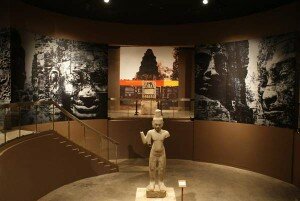 Also amusing – the quotidian wall inscriptions in Gallery E – Angkor Thom: The Pantheon of Spirits: “There were 102 hospitals in the city of Angkor Thom, and these healing centers were stocked with 1,960 boxes of salve for hemorrhoids.”
Also amusing – the quotidian wall inscriptions in Gallery E – Angkor Thom: The Pantheon of Spirits: “There were 102 hospitals in the city of Angkor Thom, and these healing centers were stocked with 1,960 boxes of salve for hemorrhoids.”
My favorite, however, is Exclusive Gallery – The Gallery of 1,000 Buddhas. The Museum’s brochure says, “This is the most prestigious collection of Buddha statues ever assembled.” I can’t speak to that (in fact, scholars say that many of the statues have no aesthetic link to the Angkor period) but stepping into this large, dark room is a real treat, and the 1,000 statues gathered around me were quite powerful in their collective strength.
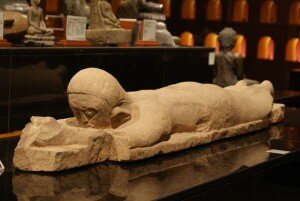 Of particular interest in the gallery are two masterpieces from the Angkorian Period (late 12th – early 13th century) – sandstone statues, both in the style of Bayon. Look for “Buddha Sheltered by Naga” and “Sumedha Hermit”. And don’t miss the Mona Lisa Buddha over on the left wall … No doubt about it – this Buddha has eyes for you! Ask a guard for help finding it.
Of particular interest in the gallery are two masterpieces from the Angkorian Period (late 12th – early 13th century) – sandstone statues, both in the style of Bayon. Look for “Buddha Sheltered by Naga” and “Sumedha Hermit”. And don’t miss the Mona Lisa Buddha over on the left wall … No doubt about it – this Buddha has eyes for you! Ask a guard for help finding it.
Also impressive in Gallery A – Khmer Civilization and Gallery B – Religion and Beliefs: The 7th-century Phnom Da “Standing Vishnu” and the blue-tinted 9th-century “Standing Shiva” from Prasat Trapeang Phong. Both reveal Cambodia’s Hindu and Brahmanist legacy.
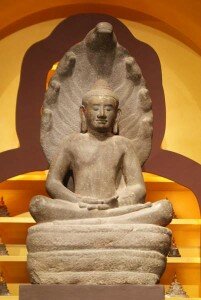 Information overload? Take a break and head to the museum coffee shop. The iced coffee drink is delicious.
Information overload? Take a break and head to the museum coffee shop. The iced coffee drink is delicious.
And while you’re sitting down, here’s the rub: The entry fee is US$12 plus another US$3 to rent the audio tour. Ouch! And disappointingly, the written English in the Museum is poorly translated from Khmer and often confusing – or worse, contradictory. Also, there’s grumbling that a Thai company owns the museum – and then well, there IS the adjacent shopping mall …
Regardless, the Angkor National Museum is an important learning center – a jewel in the Kingdom’s educational crown.
And it has air con.”
For more details see http://www.angkornationalmuseum.com/ The museum has a strict “no-photos” policy, so all the pictures in this article have been supplied by them and are reproduced with their permission.
Click any of the small pictures below to open a lightbox. You can then scroll through the whole gallery

